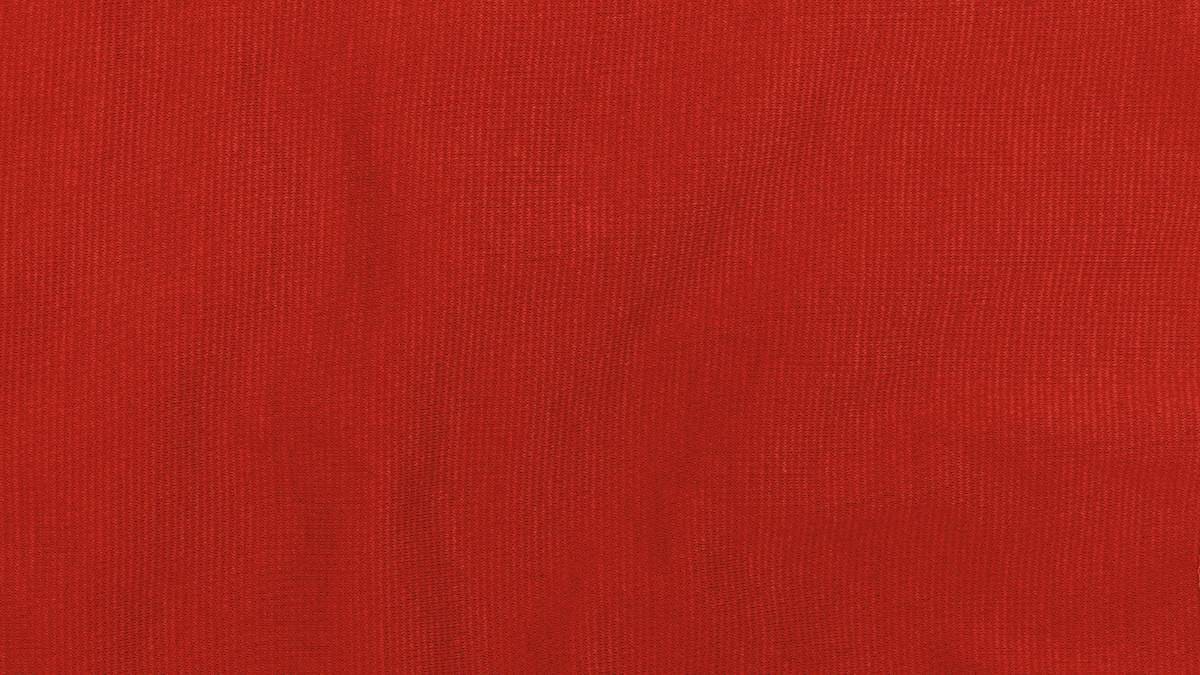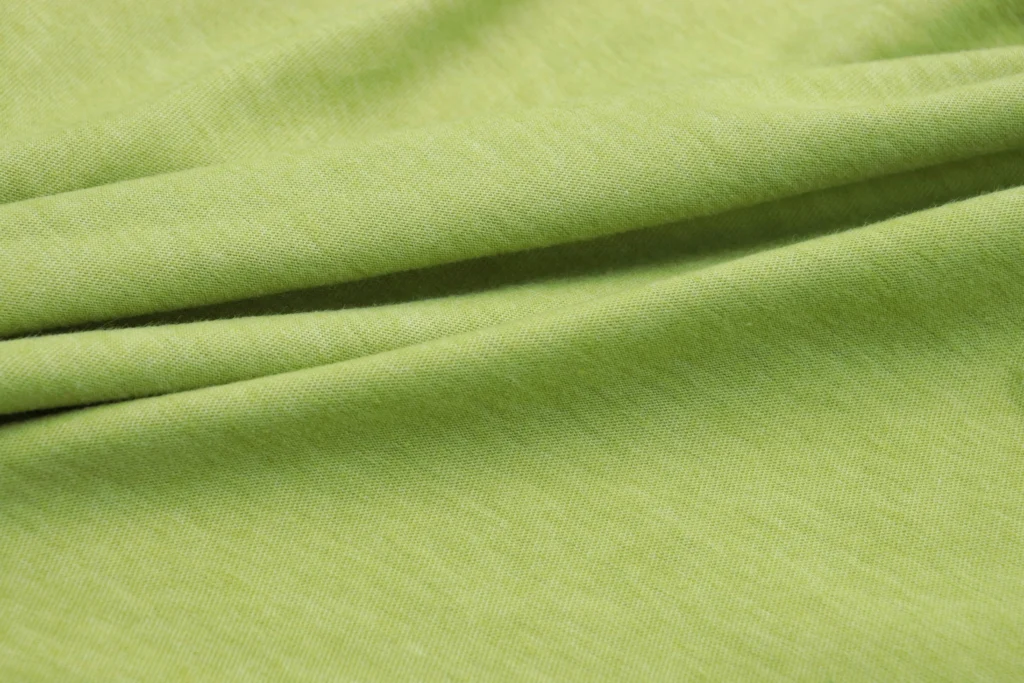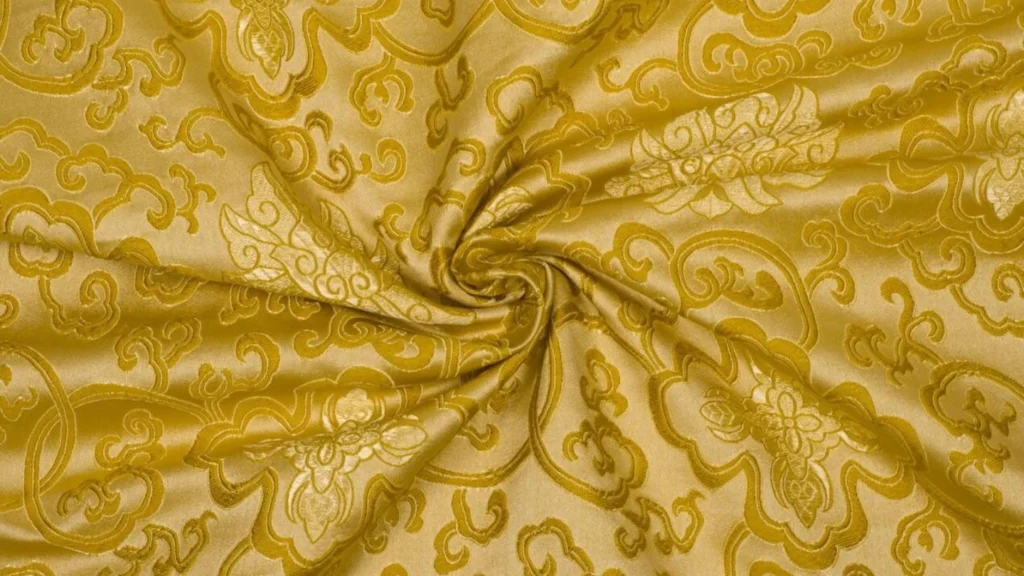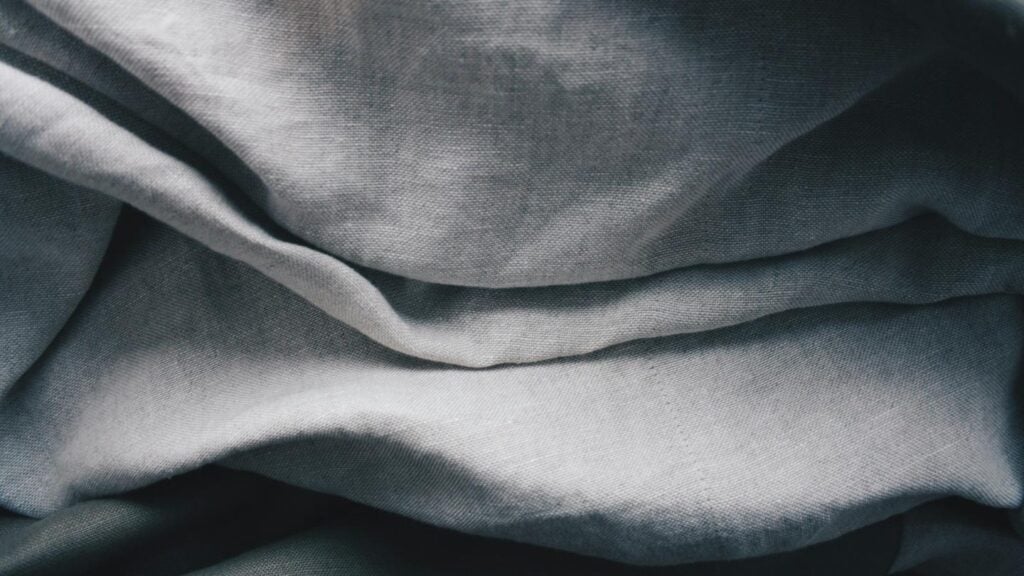2 – Benefits of Choosing Jersey Fabric
3 – Jersey Fabric vs Other Fabrics
4 – How Jersey Fabric Is Manufactured
5 – Common Uses in Fashion
6 – Understanding the Environmental Impact of Jersey Fabric
7 – Exploring Price Points and Value for Money
8 – Conclusion
9 – FAQs
What is Jersey Fabric?
Jersey fabric is a type of knit fabric known for its softness, stretchability, and comfort. It is commonly used in a variety of clothing items such as t-shirts, dresses, and activewear, making it a staple in both casual and athletic wardrobes. The fabric is woven in a way that allows it to naturally stretch, giving garments made from jersey fabric a snug fit and high level of flexibility. This makes jersey fabric incredibly versatile, offering a great balance of comfort, breathability, and durability.
Key features of jersey fabric include:
- Knit Construction: Unlike woven fabrics, which are made by interlacing threads, jersey fabric is made by knitting, a process that creates loops in the yarn. This gives it its signature stretch and softness.
- Softness and Comfort: Jersey fabric is often praised for its soft, smooth texture, which makes it a favorite for garments worn close to the skin, like t-shirts, leggings, and undergarments.
- Breathability: Because of its open knit structure, jersey fabric allows air to flow through, keeping the wearer cool and comfortable, which is why it’s often used in warm-weather clothing.
- Elasticity: The natural stretch in jersey fabric means that it stretches without losing its shape, allowing garments to move with the body.
Jersey fabric can be made from various fibers, including cotton, wool, polyester, and blends. Each fiber contributes different characteristics to the fabric, such as the softness of cotton or the moisture-wicking properties of polyester. Whether you’re lounging at home, hitting the gym, or stepping out for a casual day, jersey fabric’s versatility makes it an ideal choice for a wide range of everyday clothing.

Benefits of Choosing Jersey Fabric
Jersey fabric offers a wide range of benefits, making it a popular choice for clothing, from casual wear to athletic gear. Here are some of the key advantages of choosing jersey fabric for your product:
- Comfortable Fit: Jersey fabric’s natural stretch ensures a comfortable and flattering fit. It adapts to your body shape without feeling restrictive, offering ease of movement. This makes it perfect for activewear, loungewear, and even everyday casual wear.
- Soft and Cozy Feel: Known for its softness, jersey fabric feels gentle against the skin. Whether it’s made from cotton, bamboo, or a synthetic blend, it offers a luxurious feel that’s ideal for clothing items like t-shirts, dresses, and sleepwear.
- Breathability: Because of its knit construction, jersey fabric allows air to circulate, which helps regulate body temperature and wick away moisture. This makes it an excellent choice for warm-weather garments or for those who want a comfortable, breathable fabric for all-day wear.
- Durability: Despite its soft texture, jersey fabric is durable and can withstand regular wear and tear. Its elasticity helps it retain shape and resist stretching out, even after multiple washes, making it a long-lasting fabric choice.
- Low Maintenance: Jersey fabric is easy to care for, as it’s generally machine washable and quick to dry. This makes it a practical option for everyday clothing, especially for busy individuals who want minimal hassle when it comes to laundry.
- Versatility: Jersey fabric is highly adaptable and can be used in a variety of styles and garments. Whether you’re making a fitted dress, a loose t-shirt, or a comfortable pair of leggings, jersey fabric can be tailored to suit many different clothing designs.
- Variety of Textures and Blends: Jersey fabric can be found in various compositions, from cotton blends to synthetics like polyester. This variety means you can find jersey in different textures, weights, and finishes to suit different climates, occasions, and personal preferences.

Jersey Fabric vs Other Fabrics
When it comes to choosing fabrics for your clothing, understanding the differences between jersey fabric and other common materials is essential. Jersey fabric stands out due to its unique combination of softness, stretch, and breathability, but how does it compare to other popular fabrics like cotton, polyester, and woven fabrics? Here’s a breakdown to help you make an informed decision:
Jersey Fabric vs Cotton
- Comfort: Both jersey fabric and cotton are known for their comfort and softness. However, jersey fabric, being a knit, tends to be even stretchier and more form-fitting than regular cotton, offering a better fit for activewear or casual garments.
- Breathability: Cotton is naturally breathable and ideal for warm climates, but jersey fabric, with its knit structure, can offer better airflow and moisture-wicking properties, making it more suitable for sportswear and performance apparel.
- Durability: Cotton is strong but may lose shape over time, especially when exposed to frequent washing. Jersey fabric, with its natural elasticity, retains its shape and tends to be more resilient, even after multiple washes.
Jersey Fabric vs Polyester
- Moisture-Wicking: Polyester excels in moisture-wicking properties, making it a top choice for athletic wear. Jersey fabric made from polyester blends can also provide moisture-wicking benefits, but natural fiber blends like cotton jersey offer a more breathable and soft feel against the skin.
- Stretch and Fit: Jersey fabric, with its inherent stretchiness, conforms to the body, making it more form-fitting than polyester fabrics, which can be more rigid unless blended with spandex or elastane.
- Durability: Polyester is highly durable, resistant to wrinkles, and has a longer lifespan than most natural fibers. While jersey fabric may lose its elasticity or softness after extensive wear, polyester blends can help maintain its durability and appearance.
Jersey Fabric vs Woven Fabrics
- Stretch and Flexibility: Unlike woven fabrics, which are typically stiff and non-stretchable, jersey fabric offers significant stretch due to its knit structure. This flexibility allows for more comfortable and form-fitting garments, which makes jersey fabric a better option for activewear and casual clothing.
- Softness: Jersey fabric is generally softer than woven fabrics, such as denim or linen. It is more comfortable for skin-to-fabric contact, making it ideal for items like t-shirts and dresses, whereas woven fabrics can feel stiffer.
- Durability and Structure: Woven fabrics, due to their tight weaving process, tend to be more structured and durable. They resist wear and tear well and are better for structured garments like shirts, trousers, and jackets. Jersey fabric, while durable, may not have the same crisp structure but is excellent for more relaxed, flexible garments.
Jersey Fabric vs Knit Fabrics
- Stretch and Recovery: Both jersey fabric and other knit fabrics have a natural stretch, but jersey has a more distinct elasticity that helps it conform better to the body. Other knits, like ribbed or interlock fabrics, may offer varying degrees of stretch and structure, but jersey is often preferred for its balanced softness and flexibility.
- Uses: While jersey fabric is often used for casual, comfortable clothing like t-shirts and leggings, other knit fabrics like ribbed knits or ponte knit are used for more structured pieces like sweaters, cardigans, and dresses. Jersey remains the go-to fabric for those seeking softness and casual wear.
Jersey Fabric vs Athletic Jersey
- Material: Jersey fabric is made from cotton, polyester, or blends and is used for casual wear, while athletic jerseys are made from synthetic fibers like polyester, designed for sports and physical activities.
- Functionality: Jersey fabric is ideal for everyday clothing like t-shirts and dresses, while athletic jerseys are moisture-wicking, durable, and built for performance during physical activity.
- Durability: Athletic jerseys are more durable, especially under intense wear, while jersey fabric may degrade faster with frequent use.
- Moisture Management: Athletic jerseys are engineered to keep athletes dry and cool, while jersey fabric, especially cotton, absorbs moisture and dries slower.

How Jersey Fabric Is Manufactured
Jersey fabric is made through a knitting process that gives it its stretch and softness. Unlike woven fabrics, which interlace yarns, jersey is created by looping yarns together in a continuous knit. This process makes it highly flexible, breathable, and comfortable for a wide range of garments. Here’s a simplified breakdown of how it’s made:
1. Selecting the Yarn
Jersey fabric can be made from cotton, polyester, wool, rayon, or blends. The choice of yarn affects the texture and feel of the fabric, with cotton offering softness, polyester providing durability, and wool adding warmth.
2. Knitting Process
The yarn is knitted using a circular knitting machine, creating a single-knit fabric. This structure gives the fabric its stretch, making it ideal for comfortable, form-fitting garments. The fabric can vary in weight, from lightweight for t-shirts to heavier options for sweatshirts.
3. Finishing Treatments
After knitting, the fabric undergoes treatments like:
- Brushing for a soft texture.
- Bleaching or dyeing for color.
- Sanforizing to prevent shrinking after washing.
4. Quality Control
The fabric is inspected for consistency in texture and color. Any defects are addressed, and the fabric is rolled into bolts, ready for use in garment production.
5. Final Product
Once finished, jersey fabric is soft, stretchy, and breathable, making it perfect for t-shirts, dresses, leggings, and more.
In essence, jersey fabric is created by selecting the right yarn, knitting it into a soft, stretchy fabric, and applying finishing treatments to enhance its properties, resulting in a versatile material ideal for a wide variety of clothing.

Produce your fashion collection with us
Common Uses in Fashion
Jersey fabric is favored in fashion for its comfort, stretch, and versatility. Here are the most common ways it’s used:
- T-Shirts and Tops: Jersey is a popular choice for casual tops like t-shirts and tank tops due to its soft feel, stretch, and breathability.
- Dresses: Its stretch and flexibility make jersey ideal for casual, form-fitting dresses that offer both comfort and style.
- Activewear: With its moisture-wicking and flexible properties, jersey is commonly used in activewear like leggings, sports bras, and tank tops.
- Leggings and Loungewear: The fabric’s stretchiness and softness make it perfect for leggings, joggers, and loungewear, ensuring comfort for everyday wear.
- Underwear and Sleepwear: Jersey’s softness and flexibility make it a top choice for underwear and sleepwear, providing all-night comfort.
- Sweatshirts and Hoodies: For cooler weather, heavyweight jersey is used in sweatshirts and hoodies, offering warmth without sacrificing breathability.
- Skirts and Pants: Jersey’s stretch makes it ideal for skirts and pants, especially leggings and bodycon styles, offering a comfortable, flexible fit.

Understanding the Environmental Impact of Jersey Fabric
Jersey fabric’s environmental impact varies based on the materials used and production methods.
1. Materials
- Cotton: Conventional cotton farming uses a lot of water and chemicals, while organic cotton is a more sustainable option.
- Polyester: Made from petroleum, polyester has a high carbon footprint and is non-biodegradable, though recycled polyester offers a more eco-friendly choice.
- Wool: Renewable, but intensive farming can cause land degradation and methane emissions.
2. Manufacturing Process
Jersey fabric production consumes energy, especially during dyeing and finishing. Eco-friendly practices, such as waterless dyeing, are emerging to reduce this impact.
3. Durability and Waste
Jersey fabric can be durable, but synthetic versions may contribute to microplastic pollution and landfill waste. Recycling options for these fabrics are limited.
4. Sustainable Alternatives
- Organic Cotton: Grown without synthetic chemicals.
- Recycled Fabrics: Made from post-consumer waste, reducing the need for new materials.
- Eco-Friendly Dyeing: Natural or waterless dyes minimize chemical runoff.
Exploring Price Points and Value for Money
The price of jersey fabric varies based on material, quality, and manufacturing process. Here’s a breakdown:
1. Material and Quality
- Cotton Jersey: Conventional cotton is affordable, while organic cotton costs more due to sustainable practices.
- Polyester Jersey: More affordable than cotton, but recycled polyester may be slightly more expensive.
- Blends: Cotton-polyester or cotton-spandex blends offer a balance of price and performance, with higher-quality blends costing more.
2. Weight and Thickness
Lightweight jerseys are cheaper than heavier, thicker fabrics used for sweatshirts or activewear, as they require more raw materials and processing.
3. Production and Manufacturing
Fabrics from regions with higher labor costs or stricter environmental standards tend to be more expensive. Eco-friendly fabrics also come at a premium but offer long-term sustainability benefits.
4. Durability and Longevity
Higher-quality jersey fabrics often last longer, retain their shape, and provide better comfort, making them a better long-term value despite a higher initial cost.
5. Bulk Discounts and Supplier Relationships
Buying in bulk or establishing long-term relationships with suppliers can reduce prices, especially for larger quantities.

Conclusion
Jersey fabric is a versatile and comfortable material, prized for its stretch, softness, and breathability. While its price can vary depending on the fiber, weight, and production methods, the overall value is determined by factors such as durability, sustainability, and long-term wear. Cheaper options may offer initial savings, but higher-quality or eco-friendly jerseys provide better longevity and comfort, making them a worthwhile investment for both consumers and designers. Whether you’re choosing jersey for everyday wear, activewear, or high-end fashion, it’s essential to balance cost with quality to ensure lasting value.
FAQs
1. What is jersey fabric made from?
Jersey fabric is typically made from cotton, polyester, wool, or a blend of synthetic fibers. It can also be made from recycled materials or organic cotton for a more sustainable option.
2. What are the characteristics of jersey fabric?
Jersey fabric is soft, stretchy, and breathable. It has a smooth texture, is lightweight (though heavier versions exist), and drapes well on the body, making it comfortable for all-day wear.
3. Is jersey fabric good for summer clothing?
Yes, jersey fabric is breathable and lightweight, making it an ideal choice for summer clothing such as t-shirts, dresses, and activewear.
4. Does jersey fabric shrink after washing?
Jersey fabric, especially cotton jersey, can shrink slightly after the first wash. It’s advisable to follow care instructions and wash it in cold water to minimize shrinkage.
5. Can jersey fabric be used for activewear?
Yes, jersey fabric is a popular choice for activewear. Its stretch and moisture-wicking properties, especially when blended with synthetic fibers like polyester, make it comfortable and functional for sports and workout gear.
6. How should I care for jersey fabric?
To keep jersey fabric in good condition, it’s best to machine wash it in cold water and tumble dry on low heat. Avoid using high heat, as this can cause shrinkage or damage to the fabric.
7. Can jersey fabric be used for winter clothing?
Heavier-weight jersey fabrics, such as those blended with wool or used in sweatshirts and hoodies, can be suitable for colder weather. However, lightweight jersey is generally better for warmer months.
8. Is jersey fabric stretchy?
Yes, one of the defining characteristics of jersey fabric is its natural stretch. This is due to its knit construction, which allows the fabric to move with the body and maintain its shape.
9. Can jersey fabric be dyed?
Yes, jersey fabric can be dyed easily, especially cotton jersey. However, synthetic blends like polyester may require specific dyes for best results.
10. What are the most common uses for jersey fabric?
Jersey fabric is commonly used in t-shirts, dresses, skirts, leggings, loungewear, and activewear. It’s ideal for garments that require comfort, flexibility, and a soft feel against the skin.







